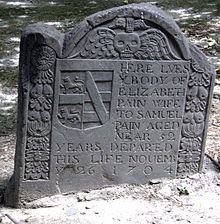Name Elizabeth Pain | Died November 26, 1704 | |
 | ||
Elizabeth Pain (c. 1652 – 26 November 1704), sometimes spelled Elizabeth Paine or Elisabeth Payne, was a settler in colonial Boston who was brought to trial after the death of her child. She was acquitted of the murder charge but found guilty of negligence, fined, and flogged. According to some writers and by popular tradition, aspects of Pain's life and her gravestone are considered an inspiration for the life and grave of character Hester Prynne in the novel The Scarlet Letter by Nathaniel Hawthorne.
Contents
Biography
Pain was a spinster who had a child out of wedlock, considered evidence of illegal fornication. She later married Samuel Pain.
On March 6, 1692, the child died. Pain was brought to trial for murder in 1693. She was found not guilty of murder but was found guilty of negligence in not seeking help. She was fined and ordered to be whipped with twenty lashes. According to court records:
Elisabeth Payne spinster being presented by the Grand Jury, in March last for murdering of hir child was now brought to the Barr & Indicted by the name of Elizabeth Payne spinster for not hauing the feare of God before hir eyes & being led by the Insitgation of the diuil did on our about the 6th day of March last wilfully murder hir child Contrary to the Peace of our Soueraigne Lord the king his Crowne & dignity the lawes of God and of this Jurisdiction holding vp hir hand at the Barr pleaded not Guilty & put hirself on tryall by God & the Country. Accordingly after the Indictment & euidences produced were read Committed to the Jury and are on file the Jury brought in their virdict not Guilty according to Indictment but greatly negligent in not Calling for help for the preservation of the childs life. The Court on Consideration of the Case for hir fornication sentenct hir to be whipt with twenty stripes paying & discharging the charge of her trjall & fees of the Court stands Committed till the sentence be performed.
Posthumous fame
Pain's grave is at King's Chapel Burying Ground in Boston, Massachusetts, and is engraved:
HERE LYES
Ye BODY OF ELIZABETH PAIN WIFE TO SAMUEL PAIN AGED NEAR 52 YEARS, DEPARTED THIS LIFE NOUEMBR
ePain's grave is in the same cemetery mentioned in The Scarlet Letter, which ends with a description of Hester Prynne's grave:
So said Hester Prynne, and glanced her sad eyes downward at the scarlet letter. And, after many, many years, a new grave was delved, near an old and sunken one, in that burial–ground beside which King’s Chapel has since been built. It was near that old and sunken grave, yet with a space between, as if the dust of the two sleepers had no right to mingle. Yet one tomb–stone served for both. All around, there were monuments carved with armorial bearings; and on this simple slab of slate—as the curious investigator may still discern, and perplex himself with the purport—there appeared the semblance of an engraved escutcheon. It bore a device, a herald’s wording of which may serve for a motto and brief description of our now concluded legend; so sombre is it, and relieved only by one ever–glowing point of light gloomier than the shadow:— “ON A FIELD, SABLE, THE LETTER A, GULES”
Pain's headstone has "an engraved escutcheon" on which enthusiasts see the letter A (for adultery): it appears in the shield to the right of two lions. Scholar Laurie Rozakis has argued that an alternate or additional source for the story may be Hester Craford, a woman flogged for fornication with John Wedg.
